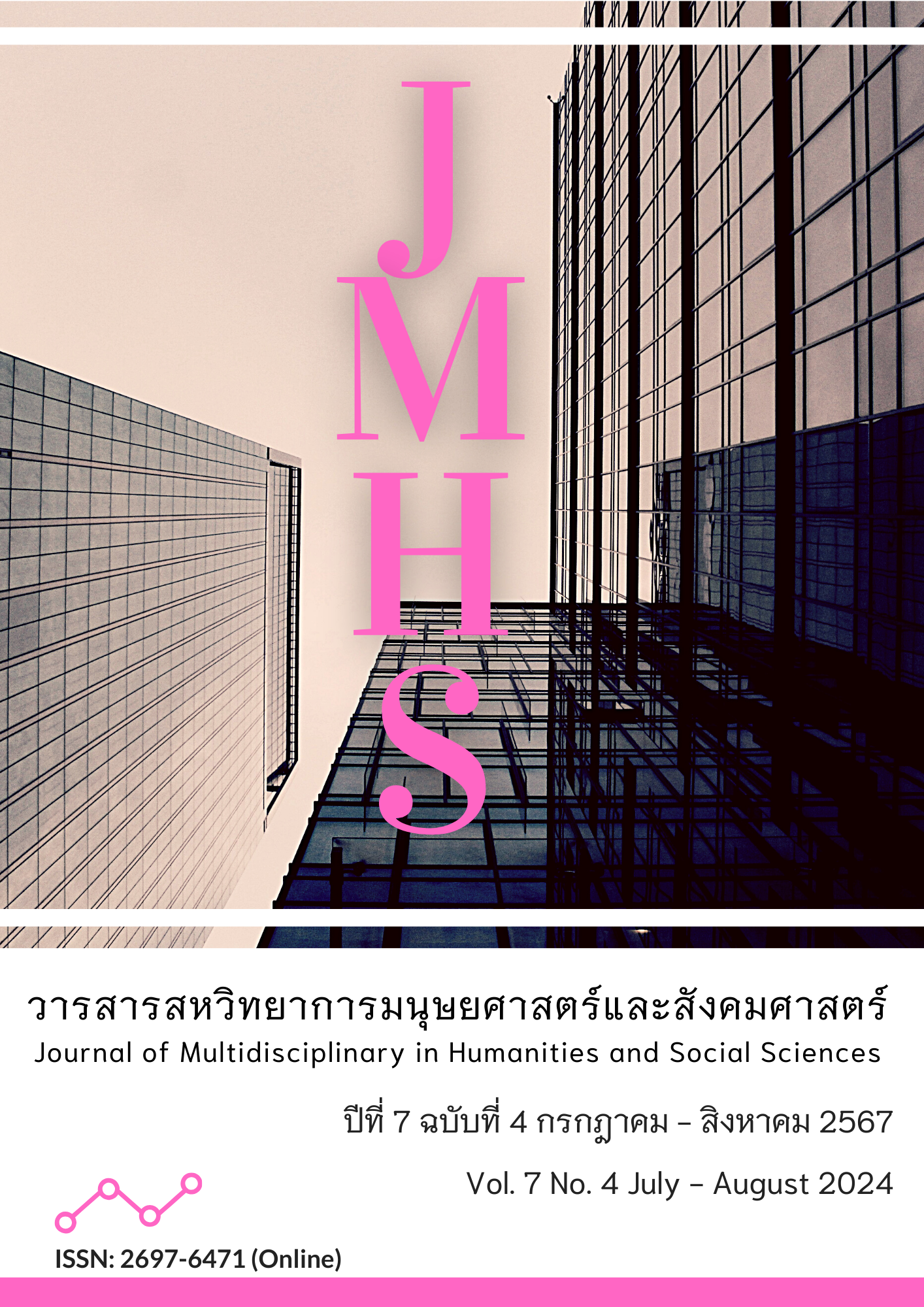Model for Developing Innovative Leadership of School Administrators Under the Chaiyaphum Provincial Administrative Organization
Main Article Content
Abstract
In the modern era, the innovative leadership of school administrators is critical to leading a school to success. The purposes of this research were to: 1. study the need assessment of innovative leadership among school administrators; and 2. design and evaluate the innovative leadership development model of school administrators under the Chaiyaphum Provincial Administrative Organization, divided into 2 phases: Phase 1: Study the current conditions. Desirable conditions and analysis of the need assessment of innovative leadership among school administrators under the Chaiyaphum Provincial Administrative Organization. Examples include school administrators and teachers. A total of 242 subjects were randomly selected. The research instrument consisted of 45 questionnaires with confidence in both.905 and.874, analyzed using basic statistics, and PNI modified. Phase 2 designed the model and evaluated it by 7 experts. The tools used were interviews and assessments. The results of the research showed that:
1. Current conditions in the development of innovative leadership of school administrators under the Chaiyaphum Provincial Administrative Organization as a whole were moderate. Overall desirable condition, garage to the highest level. The analysis of need assessment found that the first priority was flexibility and adaptability, followed by visionary, creative thinking, and individualized consideration.
2. There are four modules in the development model: 1) Adaptability and flexibility 2) Visionary 3) Creative thinking; and 4) Individualized consideration. A total of 120 hours were spent on the development of the six approaches. The results of the model evaluation showed that there were 4 elements of the highest level of suitability and feasibility and 1 element of the high level.
Article Details

This work is licensed under a Creative Commons Attribution-NonCommercial-NoDerivatives 4.0 International License.
Views and opinions appearing in the Journal it is the responsibility of the author of the article, and does not constitute the view and responsibility of the editorial team.
References
กนกอร สมปราชญ์. (2559). ภาวะผู้นำและผู้นำการเรียนรู้สำหรับผู้บริหารการศึกษา. ขอนแก่น: คลังนานาวิทยา.
จรุณี เก้าเอี้ยน. (2556). คุณลักษณะผู้นําเชิงนวัตกรรมของผู้บริหารสถานศึกษาในบริบทสังคมพหุวัฒนธรรม. มหาวิทยาลัยราชภัฏยะลา.
ธีระ รุญเจริญ. (2557). ความเป็นมืออาชีพในการจัดและบริหารการศึกษาในยุคปฏิรูปการศึกษาเพื่อปฏิรูปรอบ 2 และประเมินภายนอกรอบ 3. (พิมพ์ครั้งที่ 8). กรุงเทพฯ: ข้าวฟ่าง.
บุญชม ศรีสะอาด. (2556). การวิจัยเบื้องต้น. (พิมพ์ครั้งที่ 9). กรุงเทพฯ: สุวีริยาสาส์น.
พงษ์เสถียร เหลืองอลงกต. (2561). การจัดการเชิงกลยุทธ์. กรุงเทพฯ: ทริปเพิ้ล เอ็ดดูเคชัน.
พชรวิทย์ จันทร์ศิริสิร. (2560). นโยบายและการวางแผนกลยุทธ์สำหรับสถานศึกษายุคใหม่. มหาสารคาม: อภิชาติการพิมพ์.
ไพฑูรย์ สินลารัตน์. (2551). การเปลี่ยนผ่านการศึกษาเข้าสู่ยุคเศรษฐกิจฐานความรู้. กรุงเทพฯ: สำนักงานคณะกรรมการวิจัยแห่งชาติ.
สุกัญญา แช่มช้อย. (2560). การบริหารสถานศึกษาในยุคดิจิทัล. พิษณุโลก: มหาวิทยาลัยนเรศวร.
Ailin, M., & Lindgren, P. (2008). Innovation Leadership in Danish SMEs. In Management of Innovation and Technology, ICMIT 2008. 4th IEEE International Conference on 21-24 September 2008, pp. 98-103.
Armstrong, M. (2010). Armstrong’s Handbook of Reward Management Practice: Improving Performance Through Reward. (3rd ed.). Great Britain: Kogan Page Limited.
Bagley, R.O. (2014). The 10 Traits of Great Innovators. Retrieved from http://www.forbes.com/sites/rebeccabagley/2014/01/15/the-10-traits-of-greatinnovators.html
Charles Jennings. (2011). Social & Workplace Learning through the 70:20:10 Lens. Retrieved from http://charles-jennings.blogsport.com/2011/08/social-workplace-learning-through.html
Charney, C., & Conway, K. (2005). The Trainer’s Tool Kit. (2nd ed.). New York: American Management Association.
Delahaye, B.L. (2005). Human Resource Development: Adult Learning and Knowledge Management. Milton: John Wiley & Sons.
Dessler, G. (2002). A Frame for Human Resource Management. (2nd ed.) New Jersey: Prentice Hall.
DuBrin, A.J. (2010). Principles of Leadership. (6th ed.). Canada: South-Western, Cengage Learning.
Dyer, J.W.G., Dyer, G.H., & Dyer, W.G. (2013). Team Building: Proven Strategies for Improving Team Performance. (5th ed.). USA: John Wiley & Sons.
George, B. (2012). Developing Innovative Leaders. Retrieved from http://www.billgeorge.org/page/developing-innovative-leaders1
Gliddon, D.G. (2006). Forecasting a Competency Model for Innovation Leaders Using a Modified Delphi Technique. Ph.D. Dissertation, Pennsylvania: Pennsylvania State University.
Horth, D., & Buchner, D. (2014). Innovation Leadership: How to use innovation to lead effectively, work collaboratively, and drive results. Center for Creative Leadership, 18. https://imamhamzatcoed.edu.ng/library/ebooks/resources/Innovation_Leadership_by_david_ horth.pdf
Jong, J.P.J., & Den Hartog, D.N. (2007). How Leaders Influence Employees’ Innovative Behavior. European Journal of Innovation Management, 10(1), 41-64.
Kanaya, T., Light, D., & McMillan, K. (2005). Factors Influencing Outcomes from a Technology- Focused Professional Development Program. Journal of Research on Technology in Education, 37(3), 313-329.
Lombardo, M.M., & Eichinger, R.W. (1996). The Career Architect Development Planner. Minneapolis: Lominger.
Mankin, D. (2009). Human Resource Development. New York: Oxford University.
Mondy, R.W. (2010). Human Resource Management. (11th ed.). New Jersey: Pearson Education.
Murdoch, L.P. (2015). Innovative Behavior in Local Government: Exploring the Impact of Organizational Learning Capacity, Authentic Leadership, Psychological Empowerment, and the Moderating Role of Intrinsic Motivation. (Dissertation Doctor of Philosophy in Organizational Leadership), School of Business and Leadership, Regent University, U.S.A.
Perera, V. (2016). Innovative leadership. Retrieved from http://www.themalaymailonline.com/features/article/innovative-leadership
Robbin, S.P., & Coulter, M. (2012). Management. New Jersey: Prentice Hall.
Sims, R. R. (2006). Human Resource Development: Today and Tomorrow. Greenwich, CT: Information Age.
Smith, C.L. (2010). The Four Components Found in Innovative Organization: An Investigation of Malcolm Aldridge National Quality Award Winners Since 2000. (Dissertation Doctor of Philosophy), Capella University.
Spahr, P. (2015). What is Innovative Leadership? How Imagination Revolutionizes Business. Retrieved from http://online.stu.edu/innovative-leadership/#definition.html.
Swanson, R.A., & Holton, E.F. (2009). Foundations of Human Resource Development. San Francisco, CA: Berrett-Koehler Publisher.
Weiss, D.S., & Legrand, C. (2011). Innovative Intelligence. Ontario: John Wiley & Sons.
Wheelen, T.L, David, H, Alan N. Hoffman, & Chaeless, E.B. (2015). Strategic Management and Business Policy. New Jersey: Prentice Hall.
Werner, J.M., & DeSimone, R.L. (2010). Human Resource Development. Mason, OH: South-Western Cengage Learning.


